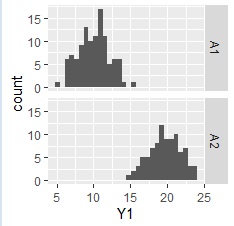
The test can quantitatively analyze the question, "Is there a difference?"
The test for the difference in mean values is one of the most basic tests. There are two columns of data, and it is assumed that the first and second columns are compared.
setwd("C:/Rtest") #
Data <- read.csv("Data.csv", header=T) #
t.test(x=Data$X1,y=Data$X2,var.equal=T,paired=F) #
setwd("C:/Rtest")#
Data <- read.csv("Data.csv", header=T)#
t.test(x=Data$X1,y=Data$X2,var.equal=F,paired=F) #
Up to two-way ANOVA, you can also use Excel's data analysis function.
The data assumes that the first column has a column name of "X" and the category, and the second column has a column name of "Y" and contains numerical values.
setwd("C:/Rtest") #
Data <- read.csv("Data.csv", header=T)#
summary(aov(Y~X,data=Data))#
The data assumes that the first and second columns have column names "X1" and "X2" with level names, and the third column has column names "Y" with numerical values.
setwd("C:/Rtest") #
Data <- read.csv("Data.csv", header=T)#
summary(aov(Y~X1+X2,data=Data)) #
When evaluating the interaction , the "+" is replaced with "*".
Repeated data is required to include the interaction term. Repeated data means that there are multiple times of data for each combination of levels of the two factors.
setwd("C:/Rtest")#
Data <- read.csv("Data.csv", header=T) #
summary(aov(Y~X1*X2,data=Data)) #
The data assumes that the column name "C1" contains the category and the column name "Y1" contains the number.
ggplot(Data, aes(x=Y1)) + geom_histogram() + facet_grid(C1~.)#

ggplot(Data, aes(x=C1, y=Y1)) + geom_point()#
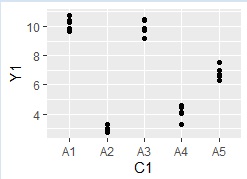
The size of the plot can be adjusted by size, and the degree of horizontal dispersion can be adjusted by the number of position = position_jitter.
ggplot(Data, aes(x=C1, y=Y1)) + geom_jitter(size=1, position=position_jitter(0.1))#
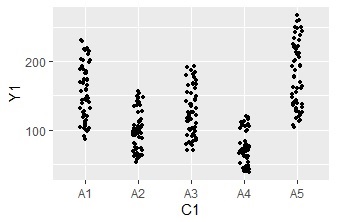
ggplot(Data, aes(x=C1, y=Y1)) + geom_boxplot()#
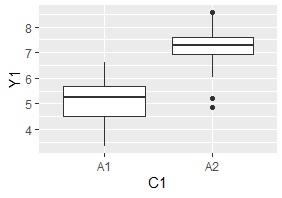
ggplot(Data, aes(x=Y1)) + geom_histogram() + facet_grid(C1+C2~.)#
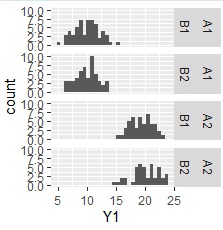
ggplot(Data, aes(x=C1, y=Y1)) + geom_jitter(size=1, position=position_jitter(0.1)) +facet_grid(.~C2)#

setwd("C:/Rtest") #
Data <- read.csv("Data.csv", header=T) #
t.test(x=Data$X1,y=Data$X2,paired=T) #
The data assumes that the first and second columns have column names "X1" and "X2", and the third column has column names "Y". "X2" is the character string that represents the correspondence.
setwd("C:/Rtest")#
Data <- read.csv("Data.csv", header=T)#
summary(aov(Y~X1+X2,data=Data))#
The data assumes that there are two columns, the column names "X1" and "X2" are in the first row, and the numbers are below them. )
setwd("C:/Rtest")#
Data <- read.csv("Data.csv", header=T)#
var.test(x=Data$X1,y=Data$X2) #
The data assumes that the first column has a column name of "X" and the category, and the second column has a column name of "Y" and contains numerical values.
setwd("C:/Rtest")#
Data <- read.csv("Data.csv", header=T) #
bartlett.test(formula=Data$Y~Data$X) #
In the case of the test of the difference between "1/10" and "4/20"
prop.test(c(1,4),c(10,20))#
It is a test of independence using the chi-square test .
setwd("C:/Rtest") #
Data <- read.csv("Data.csv", header=T)#
chisq.test(Data)#
